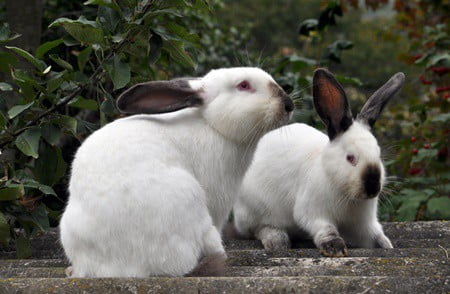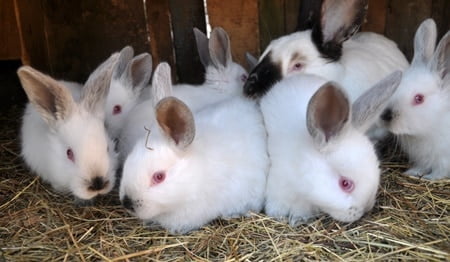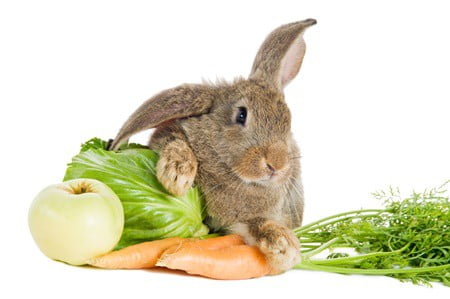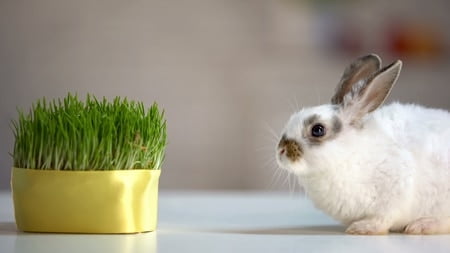Calcium is an essential nutrient in a rabbit’s diet. It’s required for healthy bones and teeth. Rabbits have a special way of processing calcium and absorb more than they need. Excess calcium in the diet increases their risk of bladder sludge and other urinary tract issues.
Rabbits with urinary tract issues eat the same diet, but with controlled portion sizes. Fresh grass has a higher water content, so using it as a replacement for hay reduces its calcium intake. Dry food can be high in calcium, so reduce the amount your rabbit eats.
The goal of a low calcium diet isn’t to eliminate calcium completely. Calcium is critical for a myriad of bodily functions, including normal teeth growth. Instead, aim to reduce the calcium your rabbit consumes to cut out any excess that leaves via the urinary tract.
Low Calcium Diet for Rabbits
If your rabbit has been diagnosed with a urinary tract issue, such as bladder sludge, your vet will recommend a low calcium diet.
Calcium is found in all elements of a rabbit’s diet, including grass hay, fresh grass, leafy greens, and pellets. However, you don’t have to remove calcium from your rabbit’s diet completely. You just need to control it by limiting your rabbit’s intake of high-calcium foods.
To find out why and how you should control calcium in a rabbit’s diet, it helps to understand how calcium is processed in a rabbit’s body.
How Do Rabbits Process Calcium?
Rabbits have an unusual way of metabolizing calcium. In most mammals, the calcium absorbed from food is regulated in the gut by the parathyroid hormone (PTH).
However, in rabbits, the absorption of calcium is less regulated. This means the amount of calcium their bodies absorb is in proportion to the amount of calcium in their diet.
According to the Journal of Animal Physiology and Animal Nutrition, rabbits absorb more calcium than their bodies need.
The more calcium a rabbit consumes, the more calcium gets absorbed in its body, whether it needs it or not.

What Causes High Calcium in Rabbits?
The excess calcium in the bloodstream absorbed from the gut is excreted in the form of urine through the urinary tract. Here, the calcium may get deposited, forming calculi.
In rabbits, solid calcifications can form in the kidneys, bladder, ureters, and urethra. Thick calcium (sludge) can also accumulate in the kidneys or bladder, leading to bladder sludge and other urinary tract issues.
It is normal to find some calcium in a healthy rabbit’s urine. According to the journal, Veterinary Record Open, the calcium is what gives their urine a slightly cloudy appearance, leaving behind a chalky residue when dried.
However, in some rabbits, calcium can bind together and form bladder sludge that is difficult to pass out, or a stone that requires surgical removal. These issues can cause further damage to the bladder and lead to recurrent urinary tract infections.
How Much Calcium Should Rabbits Have?
The recommended daily amount (RDA) of calcium for an adult rabbit is 200mg per 1kg bodyweight. This means a 2.5kg rabbit needs 500mg of calcium every day.
However, if your rabbit has been diagnosed with bladder sludge or any other urinary tract issue, chances are it has been consuming more than the RDA of calcium.
Therefore, lowering the amount of calcium may just mean cutting back so that you don’t exceed the recommended amount. Your vet will discuss how much calcium your rabbit needs based on its condition.
Calculating the amount of calcium your rabbit is currently consuming and comparing this to the recommended daily amount can help. Keep in mind that an individual rabbit’s daily requirement can vary but this should give you a baseline to work from.
How to Calculate Your Rabbit’s Calcium Intake
The formula to calculate the calcium content in different foods is as follows:
[(Weight of Food x % Dry Matter) x % Calcium] x 1000 = mg of Calcium
You’ll need this formula because the calcium content in packaged food is often given as a percentage of dry matter (what’s left behind once water is removed). All rabbit foods, including pellets, have some water in them.
Examples of low water rabbit foods include pellets (10%) and hay (13%). Fresh foods, such as fresh grass (80%) and fresh leafy greens have a higher water content.
Because calcium is given as a percentage of dry matter, high water foods may appear as if they’re higher in calcium. In reality, foods richer in water have less calcium when compared by weight.
Therefore, to measure the real amount of calcium per portion, you need to consider the weight of the food when water is removed.
Reducing Calcium in a Rabbit’s Diet
To reduce the amount of calcium your rabbit consumed, you’ll have to pay more attention to how much of each type of food your rabbit consumes. Substitute a few components with foods lower in calcium.
Grass and Hay
Grass has an optimal balance of nutrients to meet your rabbit’s needs. Even though it contains calcium, rabbits on a low-calcium diet should continue to eat plenty of fresh grass and grass hay.
Include a variety of hay in your rabbit’s diet, including timothy, orchard, and meadow. All three varieties have a calcium content of 0.3 to 0.5%, depending on the type and where the grass was cut.
Alfalfa hay is extremely high in calcium (1.3%) and should be avoided in rabbits with urinary tract problems.
Another way you can reduce your rabbit’s calcium intake is by substituting some of its hay with fresh grass.

Although hay (dried grass) and fresh grass have the same amount of calcium per blade, fresh grass has more water. This gives fresh grass more mass. Rabbits with urinary tract problems need more water and consuming more fresh grass can be beneficial for their health.
For a 2.5kg rabbit to reach its 500mg RDA of calcium, it needs 115g of hay or 500g of fresh grass. A rabbit that is given a combination of hay, grass, pellets, and greens will probably need around 330 g of grass or 75 g of hay to meet a total of 5000mg RDA of calcium from all foods.
Remember that the amount your rabbit will eat will depend on factors, such as age, activity level, breed and the types of food it has access to.
Fresh grass is just as healthy as grassy hay. Therefore, replace some of your rabbit’s hay with fresh grass. You can replace all of your rabbit’s hay with fresh grass, but you may have to make the switch more gradual to avoid emotional and gastrointestinal stress in your rabbit.
You must never restrict your rabbit’s access to hay or fresh grass. If you are aiming to reduce your rabbit’s calcium intake, it should be done by controlling other components of your pet’s diet. Hay should only be replaced with fresh grass or lower-calcium varieties of hay.
Dry Food
Dry food is rich in calcium and is the main cause of excess calcium in a rabbit’s diet. There are two ways you can control your rabbit’s intake of calcium from pellets:
- Reduce the amount of dry food in your rabbit’s diet
- Pick a brand of dry food with a lower calcium content
The most mentioned daily dry food portion is 25g of dry food per kg of your rabbit’s weight. So, if your rabbit weighs 2.5kg, it can’t be given more than 63g of dry food per day.
Rabbit pellets have an average calcium content of 0.9%. This means a 63g portion of dry food contains 510mg of calcium. Remember that a 2.5kg rabbit needs approximately 500mg of calcium. 63g of dry food exceeds the recommended amount of calcium before you even factor in grass/hay and vegetables.
The above pellet portions were provided for commercial breeding purposes so that dry food acts as a complete feed, without the use of hay or vegetables. This allows rabbits to grow quicker at a much lower cost. However, this compromises their long-term health.
Therefore, the best way to reduce your rabbit’s calcium intake is to reduce its pellet consumption. Replace the pellets with more fresh grass or hay. A 10g/kg of bodyweight portion will reduce your rabbit’s calcium consumption dramatically.
To further reduce your rabbit’s calcium intake, consider switching to a lower-calcium brand. Some brands have half the amount of calcium as others – especially ones designed for urinary tract health.
Low Calcium Vegetables and Plants
The amount of calcium in different types of plants and vegetables can vary drastically. For example, carrots have a calcium content of 0.28% and dandelion, 1.34%. Portion sizes matter too. A piece of carrot has more mass than a dandelion leaf.
Vegetables are mostly water, so they contain much lower levels of calcium when compared by weight. For example, 63g of dry food contains 510mg of calcium and 63g of kale contains 95mg of calcium. However, both kale and calcium roughly contain the same percentage of calcium (0.9 to 0.98%).

Therefore, a great way to reduce your rabbit’s calcium intake is to replace its dry food with fresh foods. It is possible to overfeed a high-calcium fresh food. Therefore, include at least 3-5 different types of vegetables every day, instead of offering the same type every day.
The following table compares the calcium content in different fresh foods.
| Type of Fresh Food | Amount of Calcium per 100g |
|---|---|
| Apple | 6mg |
| Basil | 177mg |
| Bok Choy | 105mg |
| Broccoli | 47mg |
| Cabbage | 40mg |
| Carrot | 33mg |
| Cauliflower | 22mg |
| Celery | 40mg |
| Chicory | 100mg |
| Cilantro | 67mg |
| Kale | 150mg |
| Parsnip | 36mg |
| Romaine Lettuce | 33mg |
| Collard greens | 232mg |
| Sweet pepper | 10mg |
| Watercress | 120mg |
Water Consumption
There are two ways water plays a role in urinary tract issues, such as bladder sludge:
- Drinking more water dilutes the urine and prevents sludge buildup
- But water is also a source of calcium
How Drinking More Water Prevents Bladder Sludge
Encouraging your rabbit to drink more water will help dilute its urine. It allows your rabbit to empty its bladder (urinate) more frequently, thus preventing the buildup of calcium deposits.
A rabbit needs 10 to 15% of its body weight in water every day. That’s 250 to 373 ml of water for a 2.5kg rabbit per day. Water can be obtained from drinking water as well as the food your rabbit consumes.
The best way to increase your rabbit’s water intake is to offer it a variety of fresh foods. Fresh foods have a high water content and can help elevate your rabbit’s overall water intake.
You can do this by replacing some of your rabbit’s hay and dry food with fresh grass and vegetables. This helps your rabbit hydrate itself more naturally as rabbits in the wild have limited access to fresh drinking water.
Furthermore, increasing your rabbit’s water intake with fresh food means that the amount of water is proportional to its food and calcium intake.
Remember that your rabbit should have unlimited access to fresh drinking water.
Calcium in Water
Drinking water has varying levels of calcium in it depending on the type or brand. Therefore, your rabbit may be getting some of its calcium from its water as well.
The amount of calcium in tap water varies according to the area. Some areas have hard water, while others are soft water areas.
Soft water has a negligible amount of calcium oF about 15mg per liter. However, hard water can contain up to 120 mg of calcium per liter, or 30mg of calcium per 250ml (the minimum water requirement for a 2.5kg rabbit).
If you use bottled water, choose a brand with the lowest amount of calcium.
However, keep in mind that the calcium levels in water is only an issue if you live in a hard water area or if your rabbit is given too much dry food.
Calcium is an important nutrient in a rabbit’s diet as it’s required for the proper growth of bones and teeth, as well as other body functions. However, a diet that is too high in calcium can cause bladder sludge, kidney stones and urinary tract infections in rabbits.
If your rabbit has a urinary tract problem, limit its calcium by reducing dry food, choosing urinary-tract friendly pellets, replacing hay with fresh grass and adding a variety of fresh food to your rabbit’s diet.
If you live in a hard-water area, you can reduce your rabbit’s calcium intake by increasing its consumption of water-rich fresh foods and choosing low-calcium bottled water.
Make any changes in your rabbit’s diet gradually. This will prevent emotional stress in your rabbit, if it is used to any particular food, while allowing its gut to adjust to its new diet.


hello can you help me please?I have 2 dutch rabbits …one of them has just come back from the vets.after needing a bladder flush ultrasound etc ..there was blood in his urine ….previously they were given hay pellets ,kale ,spring greens .didnt realise they were high calcium content .they are now on timothy hay meadow hay romaine lettuce and savoy cabbage on the vets recommendation .can you tell me how much in leaves they should getdaily ,and also what other low calcium veg can I give them for variety ?
Thank you for a very informative article. Though I’ve had rabbits for about 15yrs, (indoor free range), it is always helpful to read and reread quality articles on issues of concern.